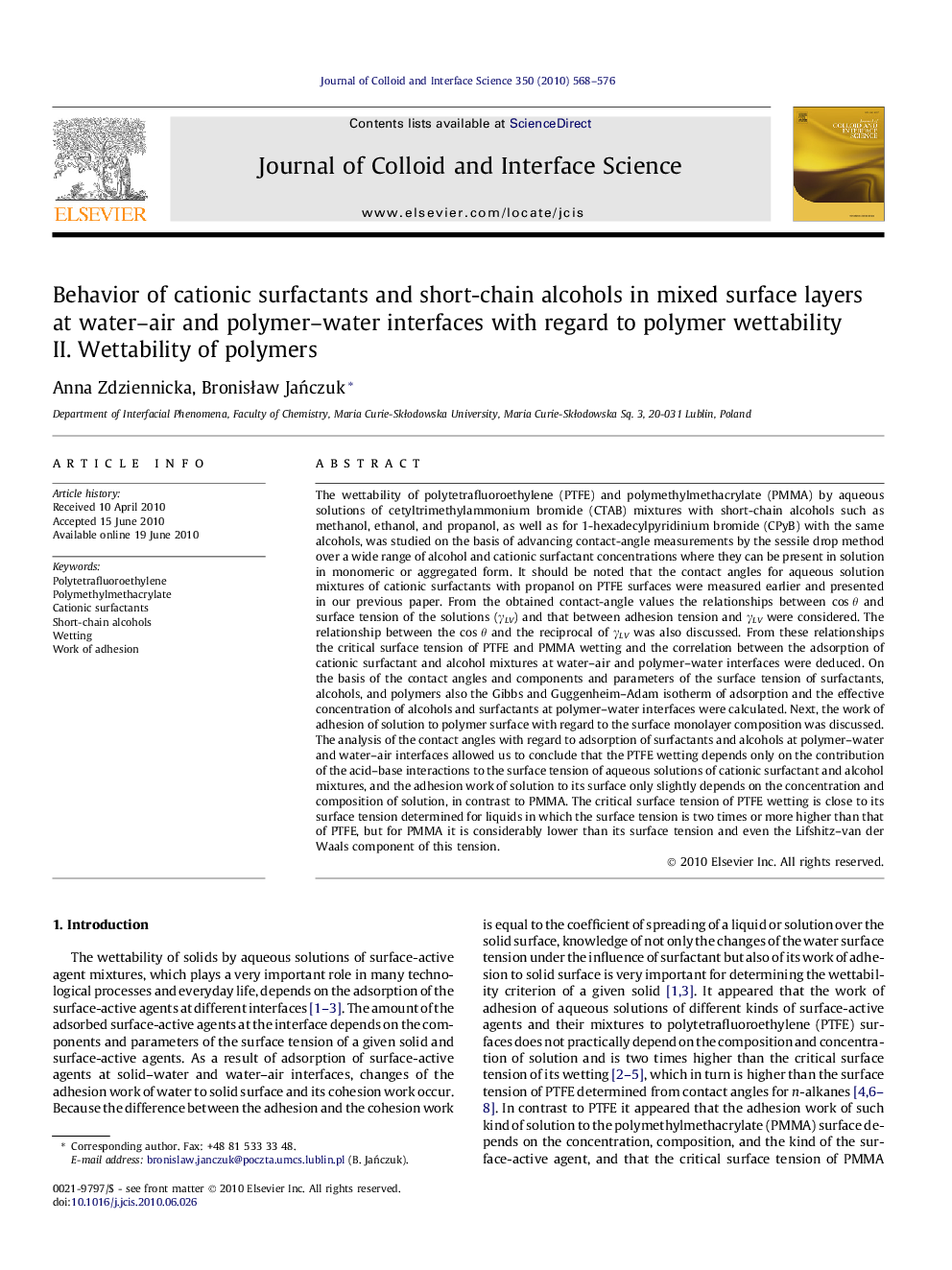| کد مقاله | کد نشریه | سال انتشار | مقاله انگلیسی | نسخه تمام متن |
|---|---|---|---|---|
| 609157 | 1454609 | 2010 | 9 صفحه PDF | دانلود رایگان |

The wettability of polytetrafluoroethylene (PTFE) and polymethylmethacrylate (PMMA) by aqueous solutions of cetyltrimethylammonium bromide (CTAB) mixtures with short-chain alcohols such as methanol, ethanol, and propanol, as well as for 1-hexadecylpyridinium bromide (CPyB) with the same alcohols, was studied on the basis of advancing contact-angle measurements by the sessile drop method over a wide range of alcohol and cationic surfactant concentrations where they can be present in solution in monomeric or aggregated form. It should be noted that the contact angles for aqueous solution mixtures of cationic surfactants with propanol on PTFE surfaces were measured earlier and presented in our previous paper. From the obtained contact-angle values the relationships between cos θ and surface tension of the solutions (γLV) and that between adhesion tension and γLV were considered. The relationship between the cos θ and the reciprocal of γLV was also discussed. From these relationships the critical surface tension of PTFE and PMMA wetting and the correlation between the adsorption of cationic surfactant and alcohol mixtures at water–air and polymer–water interfaces were deduced. On the basis of the contact angles and components and parameters of the surface tension of surfactants, alcohols, and polymers also the Gibbs and Guggenheim–Adam isotherm of adsorption and the effective concentration of alcohols and surfactants at polymer–water interfaces were calculated. Next, the work of adhesion of solution to polymer surface with regard to the surface monolayer composition was discussed. The analysis of the contact angles with regard to adsorption of surfactants and alcohols at polymer–water and water–air interfaces allowed us to conclude that the PTFE wetting depends only on the contribution of the acid–base interactions to the surface tension of aqueous solutions of cationic surfactant and alcohol mixtures, and the adhesion work of solution to its surface only slightly depends on the concentration and composition of solution, in contrast to PMMA. The critical surface tension of PTFE wetting is close to its surface tension determined for liquids in which the surface tension is two times or more higher than that of PTFE, but for PMMA it is considerably lower than its surface tension and even the Lifshitz–van der Waals component of this tension.
Mutual influence of alcohol and cationic surfactant on the wettability of PTFE and PMMA. As examples of the contact angles of aqueous solutions of “pure” CTAB at the concentration, C1, equal to 1 × 10−5, 1 × 10−4, 6 × 10−4, and 1 × 10−3 M and “pure” methanol at C2 = 3.21 M, and mixtures of CTAB and methanol at these concentrations are shown.Figure optionsDownload high-quality image (80 K)Download as PowerPoint slideResearch highlights
► Critical surface tension of PTFE wetting (γC) by solutions of surfactants is close to its γSV.
► γC of PMMA for these solutions is lower from Lifshitz-van der Waals component of its γSV.
► Adhesion work (WA) of surfactants solutions to PTFE surface is practically constants.
► WA of solutions to PMMA surface depends on CTAB, CPyB and alcohols concentration.
Journal: Journal of Colloid and Interface Science - Volume 350, Issue 2, 15 October 2010, Pages 568–576